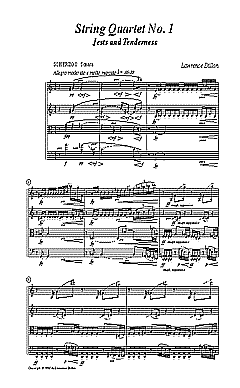String Quartet No. 1
| SCHERZO I: Sonata 8:25 | |
| SCHERZO II: Scherzo 4:35 | |
| SCHERZO III: Fugue 5:00 | |
| Nocturne: 10:30 |
 Composed in the summer of 1998, Jests and Tenderness is a meditation on the Classical scherzo. Traditionally, the scherzo (Italian for “joke”) is a fast, jovial movement in three-part form. In the eighteenth and nineteenth centuries, composers took advantage of the scherzo movement as an opportunity to play jokes on the listener, on other composers, or even on the performers themselves.
Composed in the summer of 1998, Jests and Tenderness is a meditation on the Classical scherzo. Traditionally, the scherzo (Italian for “joke”) is a fast, jovial movement in three-part form. In the eighteenth and nineteenth centuries, composers took advantage of the scherzo movement as an opportunity to play jokes on the listener, on other composers, or even on the performers themselves.
In more recent times, inquiries into the anthropological and psychological roots of humor have taught us that a “joke” is often more than it seems: humor has many uses, from promoting cooperation to veiling hostility. The quip that serves to relieve tension in one setting can easily increase tension in another. One of our most versatile coping mechanisms, humor is a weapon that wounds and heals.
Jests and Tenderness digs beneath the aggressive edge of humor, revealing what is left behind when the energy has been stripped away. Accordingly, the first three movements are scherzi — though their forms vary, they are all relentlessly brisk, capricious, and even, at times, manic in character. A wide range of comic treatment is featured throughout, from subtle parody to blatant slapstick.
The first movement pokes fun at two different musical cliches: first the abrasive monotony of contemporary popular music, then the elitist pretensions of the current classical music scene. These two poses become the contrasting ideas in a sonata form that attempts (and fails) to resolve the conflicts between them.
Most everything about the second movement — the triple meter, the ternary form, the rapid tempo, the frequent hemiolas — is typical of a classical scherzo. The only neoteric wrinkles are in the edgy harmonies and odd phrasing: the entire movement is cast in eleven-bar groups, which makes the pacing unpredictable and a little ungainly.
A brief but vigorous fugue, the third movement pushes beyond the limits of decorum, where wit devolves into hyperactive energy. The conclusion culminates in a cadenza for the viola which leads directly into the last movement. With a duration as long as the middle two movements combined, this final nocturne is both a response to and a consummation of the preceding frenzy. Its four sections evoke the serenity and mystery of the night, with a coda that fades off into silence. While the first three movements seek to exhaust the energy of humor, the last seems to ask “How should we respond to aggression?” — a question that is, in both its personal and social forms, both timely and timeless.
Jests and Tenderness was premiered by the Mendelssohn String Quartet at the North Carolina School of the Arts on October 14th, 2000.
ORDER JESTS AND TENDERNESS:
- score and parts: American Composers Editions
- recording with Mendelssohn String Quartet: www.albanyrecords.com